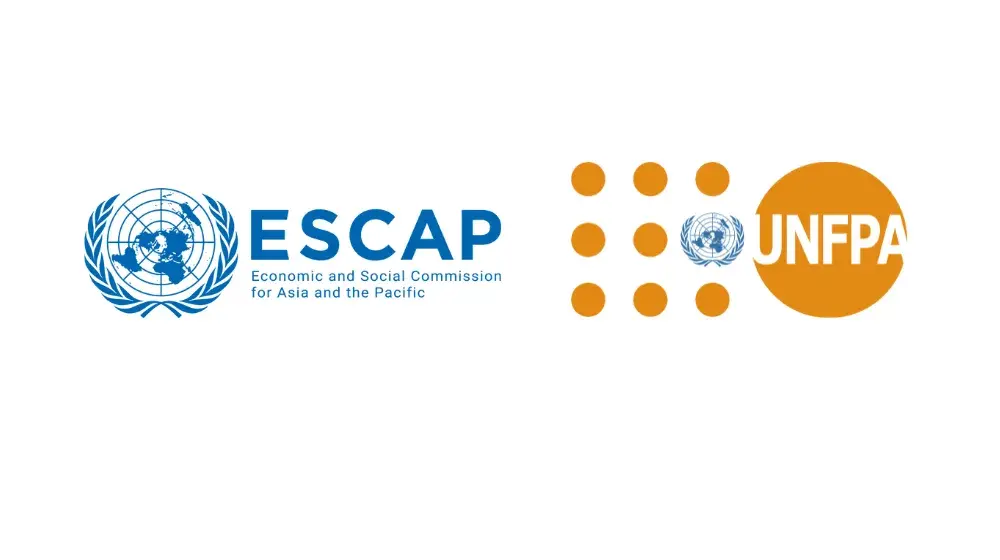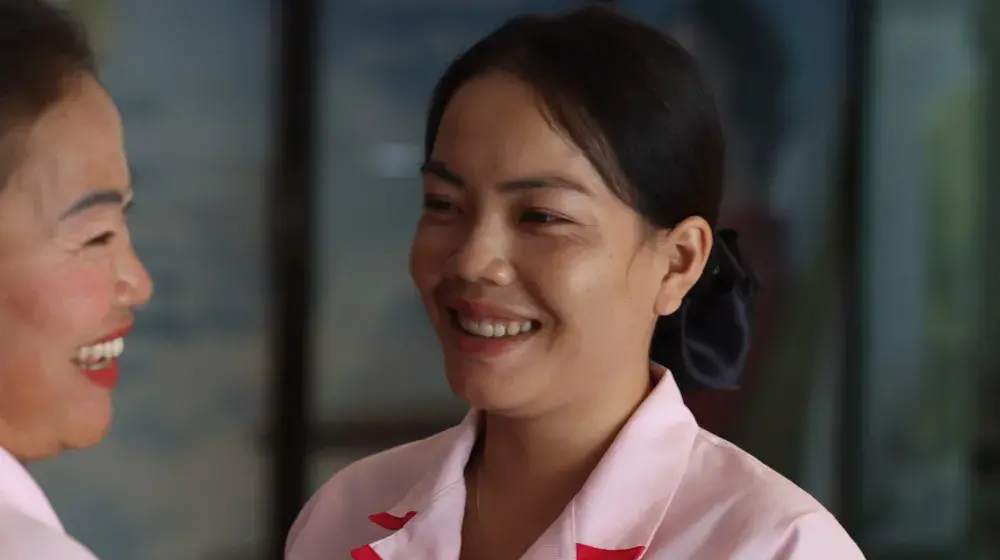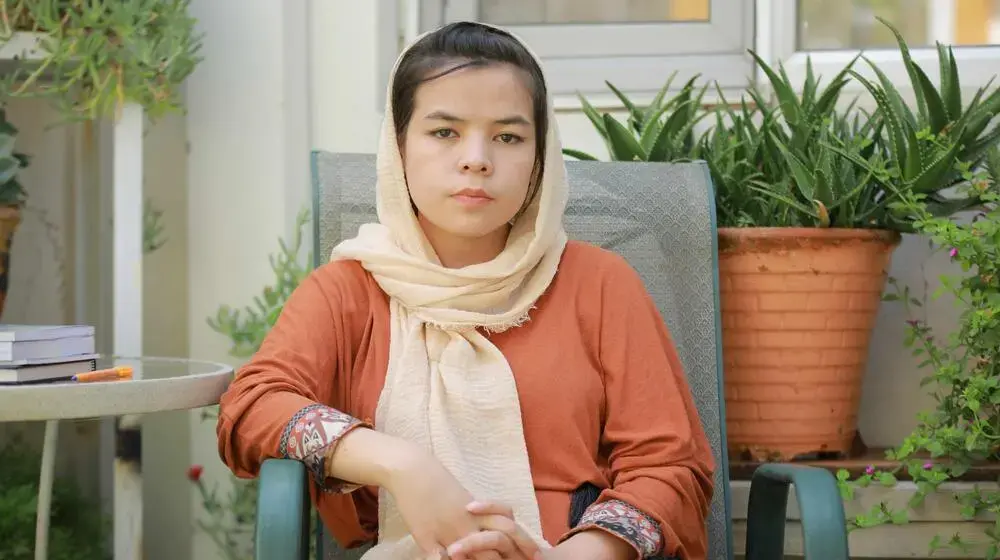NAYAPARA REFUGEE CAMP, COX’S BAZAR DISTRICT, Bangladesh - On an overcast June morning, a large group of Rohingya refugee women were waiting their turn at the maternity centre within the Nayapara Refugee Camp’s main medical facility.
Suddenly, an older woman arrived with her heavily pregnant daughter, seeking urgent help. A quick assessment made it clear that 20-year-old Salima Khatum was about to give birth to her second child.
Rondi Anderson, UNFPA Bangladesh’s International Midwifery Specialist, who happened to be visiting that very day, swung into action along with a team of paramedics and midwives.
Salima Khatum, in the throes of labour, receives midwifery care at the Nayapara Rohingya Refugee Camp’s birthing centre, Cox’s Bazar (Image: UNFPA Bangladesh/Allison Joyce)
The care Salima Khatum received was the result of UNFPA’s support to the Bangladesh Government to create a midwifery diploma programme to ensure high quality services and the placement of midwives where they are needed the most, including Rohingya refugee camps and host communities.
“There’s a clear nexus here between increasing capacity to ensure safer pregnancy and childbirth for the most vulnerable women in Bangladesh itself and the ability to respond better to humanitarian needs, as with the Rohingya situation,” explained Ms. Anderson. “Midwives save lives, it’s that simple.”
Afroza Banu, among the first batch of midwives to graduate in 2015, was deployed to Cox’s Bazar, far from the Rajshahi Nursing Institute, one of the institutions where the three-year diploma course originated. She’s one of seven midwives currently working at the Nayapara facility.
At first, the challenges were huge for Afroza Banu, including her inability to communicate with Rohingya women in their language, as well as understanding how their sociocultural background impacted their ability to access sexual and reproductive health information and services.
But she gradually learnt how to speak Chittagonian, the local language in Cox’s Bazar which is similar to Rohingya, and with better communication she was better able to respond to the refugees’ needs and form a bond with the Nayapara community.
“So many of them are traumatized with what happened to them,” Afroza Banu says, referring to the violence that erupted in Myanmar’s Rakhine State last August, triggering the latest phase of the long-running Rohingya crisis.
“They suffered sexual assault, grievous injuries. Many of them swam across the Naf River to reach Bangladesh. They were starving and dehydrated when they arrived, including many pregnant women.”
Midwife Afroza Banu tends to a patient at the Nayapara Rohingya Refugee Camp’s maternity clinic, Cox’s Bazar (Image: UNFPA Bangladesh/Allison Joyce)
The population of Nayapara camp, previously around 30,000 people, now stands at well over 70,000, creating tremendous demand for essential resources and services.
The women who show up at the Nayapara maternity facility are very young, notes Shayla Akter, one of the two paramedics there. “By the time they are 15 to 18 years old, many already have children, sometimes several. We counsel them about family planning and provide them wide options for contraception. Many are now starting to understand the importance of birth spacing.”
The Nayapara maternity facility provides short acting contraceptive methods through midwives and also has doctors who can offer long acting methods. A whiteboard in Akter’s office notes the progress being made month after month in the uptake of contraception and other family planning services by both longtime Rohingya residents in the Nayapara camp, many of whom were born there to parents who fled previous bouts of violence in Myanmar, as well as by new arrivals over the past ten months.
Salima Khatum, the woman in the throes of labour that morning, had her first child three-and-a-half years ago, after which she used contraception before choosing to conceive again. When asked whether she would have more children, she said no, two were enough.
Two hours later she gave birth to a healthy baby girl. Spirits were high in the Nayapara birthing room, from a smiling although exhausted mother cradling her newborn to the elated midwives themselves.
“For me, when I help deliver a baby, it’s such a pleasure,” said Afroza Banu. “I will eventually return to my home district at some point, but the experience I’ve had here in Nayapara, helping the Rohingya refugees, I will always carry that with me.”
-------
UNFPA’s services in Nayapara Refugee Camp and beyond:
The Nayapara maternity center is fully supported by UNFPA as are the sexual and reproductive health (SRH) services at 19 other facilities both within and around the Rohingya refugee camps.
UNFPA is supplying contraceptives and training community health workers. UNFPA also provides reproductive health kits for all aspects of the Minimum Initial Service Package as well as regular training to partners as well.
Currently there is a sexually transmitted infections (STI) training running for midwives in Cox’s Bazar, part of a series of SRH related training UNFPA has supported.
UNFPA-supported facilities/midwives provide clinical management of rape, STI, initial stabilization of obstetric emergencies, family planning, referral for gender-based violence, counseling for unwanted pregnancy and emergency transport.
In addition, UNFPA supports comprehensive emergency care at three referral centers.
UNFPA and midwifery in Bangladesh:
In 2010, the Government's commitment to the UN Secretary-General’s Every Woman, Every Child initiative included:
- Creation of a cadre of midwives in Bangladesh
- Education and deployment of 3000 midwives in sub-districts and below in five years
There are two streams of midwifery in Bangladesh: 1600 nurse midwives have been upgraded to certified midwives so far, with six months post-basic education; and 1800 diploma midwives, who undergo three years of study, have graduated so far (as of June 2018).
1200 certified midwives have been deployed in public health facilities since 2016. The first batch of diploma midwives will be deployed to sub-district hospitals from July 1, 2018. Annually 600 midwives will be recruited until the 3000 posts are filled.
Bangladesh needs about 20,000 midwives in the public sector – each midwife can conduct up to 175 deliveries a year based on WHO standards.





